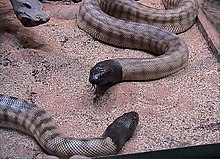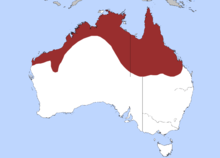| Black-headed python | |
|---|---|

| |
| Conservation status | |
 Least Concern (IUCN 3.1) | |
| Scientific classification | |
| Domain: | Eukaryota |
| Kingdom: | Animalia |
| Phylum: | Chordata |
| Class: | Reptilia |
| Order: | Squamata |
| Suborder: | Serpentes |
| Family: | Pythonidae |
| Genus: | Aspidites |
| Species: | A. melanocephalus |
| Binomial name | |
| Aspidites melanocephalus (Krefft, 1864) | |

| |
| Distribution of the black-headed python | |
| Synonyms | |
| |
The black-headed python (Aspidites melanocephalus) is a species of snake in the family Pythonidae (the python family). The species is endemic to Australia. There are no subspecies that are recognized as being valid.
Description


Adults of A. melanocephalus typically grow to 1.5–2 m (4.9–6.6 ft) in length (including tail), but can grow to a maximum length of 3.5 m (11 ft). The body is muscular with a flattened profile, while the tail tapers to a thin point.
The top of the head is covered by large symmetrical scales. The dorsal scales, which are smooth and glossy, number 50-65 rows at midbody, while 315-355 ventral scales occur. The tail has 60-75 mainly single subcaudal scales and the anal scale is single. The posterior subcaudals tend to be divided, often irregularly.
The color pattern consists of shades of black, dark grey, brown, gold, and cream arranged in a banded or brindled pattern. The belly is light-colored, flecked with darker spots. The head is shiny black that also extends down the neck and throat for several inches.
Distribution and habitat
The species A. melanocephalus is found in Australia, in the northern half of the country, excluding the very arid regions. The type locality given is "Port Denison Bowen", Queensland, Australia. It occurs in humid tropical to semiarid conditions.

Behavior
A. melanocephalus is terrestrial and is often found amongst rocks and loose debris. If disturbed, it hisses loudly, but is unlikely to bite unless hunting prey. It sometimes strikes with a closed mouth, but generally can be handled easily. It is a strong swimmer, but is almost never found in water. It is not venomous.
Feeding
The diet of A. melanocephalus consists mainly of reptiles, including snakes, but it will eat mammals and some birds if available. Skinks are the primary prey of the black-headed python. Other important prey include geckos, bearded dragons, legless lizards and the perentie, the largest monitor lizard native to Australia, as well as other black-headed pythons. When ingesting large prey, it positions one or two coils just ahead of its distended mouth and by constriction makes the task of swallowing easier.
Reproduction
A. melanocephalus is oviparous. Adult females lay five to 10 eggs per clutch. The females stay coiled about the eggs and incubate them until they hatch, which is usually after 2–3 months. The young take small prey as soon as two days after hatching. Immature individuals are vulnerable to predation. Adults have no natural predators other than dingos and humans.
Captivity
Due to its docile nature and striking color pattern, A. melanocephalus has become very desirable as an exotic pet. It is bred in captivity and can be relatively easily obtained, but does command a high price. As it can be a muscular snake and reaches a fairly substantial size, prospective owners should consider a suitable enclosure, as well as temperature and feeding requirements.
In human culture
A. melanocephalus is mentioned in, or plays a central role in, the stories of the Indigenous Australians Dreamtime tradition.
References
- Shea G, Ellis R, Wilson S (2017). "Aspidites melanocephalus ". IUCN Red List of Threatened Species. 2017: e.T13300710A13300718. doi:10.2305/IUCN.UK.2017-3.RLTS.T13300710A13300718.en. Retrieved 19 November 2021.
{{cite journal}}: CS1 maint: multiple names: authors list (link) - ^ McDiarmid RW, Campbell JA, Touré TA (1999). Snake Species of the World: A Taxonomic and Geographic Reference, Vol. 1. Washington, District of Columbia: Herpetologists' League. 511 pp. ISBN 1-893777-00-6 (series). ISBN 1-893777-01-4 (volume).
- Mehrtens JM (1987). Living Snakes of the World in Color. New York: Sterling Publishers. 480 pp. ISBN 0-8069-6460-X.
- Krefft G (1869). The Snakes of Australia; An Illustrated and Descriptive Catalogue of All the Known Species. Sydney: Thomas Richards, Government Printer. xxv + 100 pp. + index + Plates I–XII. (Aspidiotes melanocephalus, pp. 33–34 + Plate III & Plate V, figure 4).
- Burnie, David; Wilson, Don E. (Editors-in-Chief) (2001). Animal. London: Dorling Kindersley. 624 pp. ISBN 0-7894-7764-5.
- ^ "Aspidites melanocephalus (Black-headed Python)". Animal Diversity Web.
- White, Robyn White (19 October 2023). "Cannibalistic Snake Devours Fellow Black-Headed Python Alive". Newsweek.
Further reading
- Boulenger GA (1893). Catalogue of the Snakes in the British Museum (Natural History). Volume I., Containing the Families ... Boidæ .... London: Trustees of the British Museum (Natural History). (Taylor and Francis, printers). xiii + 448 pp. + Plates I–XXVIII. (Aspidites melanocephalus, p. 91).
- Cogger HG (2014). Reptiles and Amphibians of Australia, Seventh Edition. Clayton, Victoria, Australia: CSIRO Publishing. xxx + 1,033 pp. ISBN 978-0643100350.
- Krefft G (1864). "Description of Aspidiotes melanocephalus, a New Snake from Port Denison, N.E. Australia". Proceedings of the Zoological Society of London 1864: 20-22.
- Wilson S, Swan G (2013). A Complete Guide to Reptiles of Australia, Fourth Edition. Sydney: New Holland Publishers. 522 pp. ISBN 978-1921517280.
External links
- Black-headed Python video Accessed 30 June 2013
- Aspidites melanocephalus at the Reptarium.cz Reptile Database. Accessed 19 September 2007.
- The Creation Story of the Wardaman People at Renewing Women's Business. Accessed 19 September 2007.
- Black-Headed Python at Zoos Victoria. Accessed 19 September 2007.
- Aspidites melanocephalus at Python Pete Reptiles. Accessed 19 September 2007.
| Family Pythonidae | |
|---|---|
| Antaresia | |
| Apodora | |
| Aspidites | |
| Bothrochilus | |
| Leiopython | |
| Liasis | |
| Malayopython | |
| Morelia | |
| Nyctophilopython | |
| Python | |
| Simalia | |
| Taxon identifiers | |
|---|---|
| Aspidites melanocephalus | |